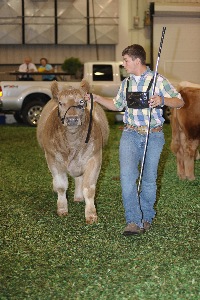Publications to assist in biosecurity before, during, and after livestock exhibitions
KDA provides tips to minimize spread of diseases during fair and expo season.

MANHATTAN, Kan. – Fairs and expos are a chance for young livestock exhibitors to have fun and show off their hard work. Friendships and lessons learned will stay with youth long after the event is over. However, something else may also linger - diseases that can infect other animals.
“Biosecurity is simply another way of saying infectious diseases,” said Kendra Frasier, animal disease traceability coordinator at the Kansas Department of Agriculture.
People may not know all the ways disease can be transmitted to animals, Frasier said, adding that just like humans, animals can get diseases from different places. These include diseases transferred from animal to animal as well as diseases from humans.
“We wanted to provide a resource for people to think about biosecurity and disease transmission,” Frasier said of new biosecurity fact sheets available from the KDA. “By thinking about the different pathways of how animals get sick, exhibitors will be able to make adjustments at home and while at the event to keep their animals healthy.”
The catalyst for vigilance in the area was the avian influenza outbreak last year that kept poultry exhibits out of the Kansas State Fair. Another disease that inspired action was vesticular stomatitis found in horses that plagued Colorado several years ago.
Because different species of animals pass diseases through different channels, KDA produced information for cattle, sheep, poultry, rabbits, swine, goats, and horses.
“The Kansas State Fair requires a health certificate within 30 days of arriving at the fair,” Frasier said. “Now that’s not necessarily a rule for a county fair, but it is for the Kansas State Fair. It is important to make sure your livestock are up to date on any vaccines they need. If you have questions about what a vaccination schedule should include you can contact your veterinarian.”
The 2016 Kansas State Fair is Sept. 9-18.
In addition to ensuring all paperwork is complete, Frasier noted the importance of making sure animals look healthy. Droopy ears, nasal discharge, decreased appetite, coughing, and other changes could be a sign of poor health and shouldn’t be bought to the event.
Bring only clean, disinfected equipment and supplies to the event, she added, which prevents the possibility of disease being spread from your exhibit to other animals.
While at the event, watch for any signs of illness, including unusual behavior.
“If your animal has any signs of illness or if you suspect it might, notify an authority at the event,” Frasier said. “The Kansas State Fair has a veterinarian on call. We as animal health officials through the Kansas Department of Agriculture are also at the State Fair.
Frasier advises exhibitors to avoid contact with animals other than his or her own, especially close nose-to-nose contact. In addition, exhibitors should limit the number of people in direct contact with the animal, and to not share feed, water, or grooming supplies with others as they could be contaminated.
“The last thing that you want to do is pick up a disease at the event and then bring it home to your herd or flock,” Frasier said. “We recommend isolating livestock that was at the event from the rest of the herd for approximately 21 days - the usual incubation period for most diseases. Once they’ve been isolated for 21 days you know if the animals are going to be sick. The isolation area should be as far from other animals as is practical. It should at least prevent nose-to-nose contact. Again, if you’ve got questions about what that means or what that looks like contact a veterinarian.”
Having a good working relationship with a veterinarian who knows your operation is helpful.
“Once there is an isolation plan and the animals are isolated, you want to make sure you care for those isolated animals last every day,” Frasier said. “Only after caring for the healthy, non-isolated animals should someone care for those isolated animals so he or she isn’t going back through the healthy animal pens. Also, do not share equipment between the isolated animals and the non-isolated animals. Monitor the isolated livestock for any signs of illness and if needed, contact your veterinarian.”
It is imperative to allow a sick animal to recover before exhibiting it again, both for the animal’s wellbeing and other animals at the show, she said.
Although the Kansas State Fair is identified in the fact sheets, the methods outlined are useful for all livestock exhibitions and can be helpful for those who do not exhibit livestock. Places like sale barns and others where an animal leaves your farm for another place and returns could pose a disease risk.
For more information, visit https://agriculture.ks.gov/divisions-programs/division-of-animal-health/animal-disease-control-and-traceability/biosecurity-resources .
-30-
K-State Research and Extension is a short name for the Kansas State University Agricultural Experiment Station and Cooperative Extension Service, a program designed to generate and distribute useful knowledge for the well-being of Kansans. Supported by county, state, federal and private funds, the program has county Extension offices, experiment fields, area Extension offices and regional research centers statewide. Its headquarters is on the K-State campus, Manhattan.
Story by:
Connor Orrock
K-State Research and Extension
cworrock@ksu.edu
For more information:
Kendra Frasier, Animal Disease Traceability Coordinator
Kansas Department of Agriculture
785-564-6606
